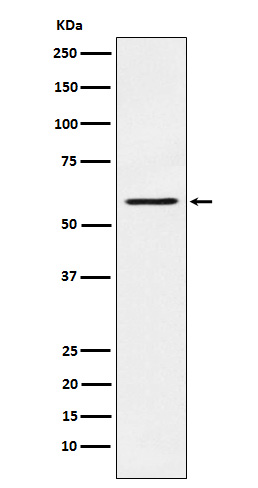
| WB | 咨询技术 | Human,Mouse,Rat |
| IF | 1/20-1/50 | Human,Mouse,Rat |
| IHC | IHC:1/100-1/200;IHF:1/50-1/200 | Human,Mouse,Rat |
| ICC | 1/50-1/200 | Human,Mouse,Rat |
| FCM | 1/20-1/100 | Human,Mouse,Rat |
| Elisa | 咨询技术 | Human,Mouse,Rat |
| Aliases | ADRB2; p21 activated kinase 1; p65 PAK; PAK alpha; Pak1; Paka; PAKalpha; Protein kinase MUK2;;PAK1 |
| WB Predicted band size | Calculated MW: 61 kDa ; Observed MW: 66 kDa |
| Host/Isotype | Rabbit IgG |
| Antibody Type | Primary antibody |
| Storage | Store at 4°C short term. Aliquot and store at -20°C long term. Avoid freeze/thaw cycles. |
| Species Reactivity | Human,Mouse,Rat |
| Immunogen | A synthesized peptide derived from human PAK1 |
| Formulation | Purified antibody in PBS with 0.05% sodium azide,0.05% BSA and 50% glycerol. |
+ +
以下是3篇关于PAK1抗体的参考文献及其摘要内容概括:
---
1. **文献名称**: *PAK1-mediated phosphorylation of MEK1 regulates cell migration*
**作者**: Zhao ZS, Manser E.
**摘要**: 该研究利用PAK1特异性抗体,通过免疫沉淀和Western blot技术,揭示了PAK1激酶通过磷酸化MEK1调控细胞迁移的分子机制,为肿瘤转移研究提供了新靶点。
---
2. **文献名称**: *Role of PAK1 in breast cancer progression and its interaction with HER2*
**作者**: Wang RA, et al.
**摘要**: 通过免疫组化(PAK1抗体)和基因沉默实验,证明PAK1在HER2阳性乳腺癌中高表达,且其活性与患者预后负相关,提示PAK1可能成为治疗耐药性乳腺癌的生物标志物。
---
3. **文献名称**: *PAK1 inhibition suppresses neurofibromatosis type 2-associated schwannoma growth*
**作者**: Hirokawa Y, et al.
**摘要**: 研究使用PAK1抗体检测神经纤维瘤病II型相关雪旺氏瘤中PAK1的激活状态,发现小分子抑制剂靶向PAK1可显著抑制肿瘤增殖,为临床治疗提供了潜在策略。
---
以上文献均聚焦于PAK1在疾病中的作用机制研究,并明确提及PAK1抗体在蛋白活性检测或定位分析中的关键应用。
The PAK1 (p21-activated kinase 1) antibody is a key tool for studying the role of PAK1. a serine/threonine kinase belonging to the PAK family. PAK1 is activated by binding to Rho GTPases like Cdc42 and Rac, which triggers conformational changes and autophosphorylation, enabling its kinase activity. It regulates diverse cellular processes, including cytoskeletal reorganization, cell motility, proliferation, survival, and gene expression. PAK1 dysregulation is implicated in cancer progression, neurological disorders, and infectious diseases, making it a significant therapeutic target.
PAK1 antibodies are widely used in techniques such as Western blotting, immunohistochemistry (IHC), immunofluorescence (IF), and immunoprecipitation (IP) to detect PAK1 expression, localization, and activation states in cells or tissues. Specific antibodies may target distinct regions of PAK1. such as its kinase domain or regulatory motifs, to study functional interactions or phosphorylation events (e.g., at Thr423). Researchers also utilize PAK1 antibodies to explore its signaling crosstalk with pathways like MAPK/ERK and PI3K/AKT, as well as its role in tumor invasiveness, synaptic plasticity, and pathogen-host interactions. Commercial PAK1 antibodies vary in host species, clonality, and validation data, necessitating careful selection based on experimental requirements.
×